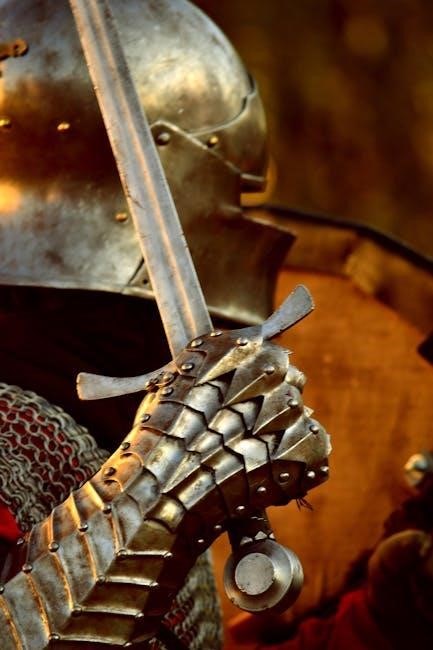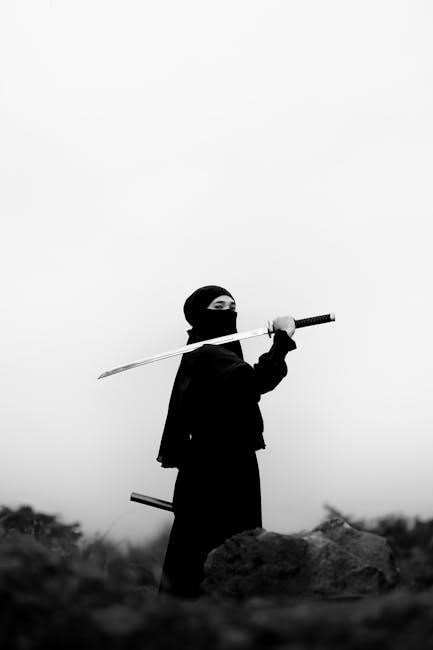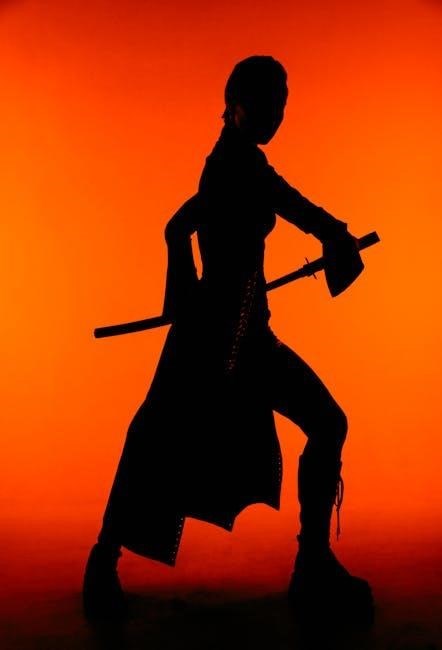The Sword of Kaigen is a captivating military fantasy novel by M.L. Wang, published in 2019. Set in the Shirojima region of the Kaigenese Empire, it explores themes of tradition, family, and sacrifice. The story follows Mamoru Matsuda, a young warrior, and his mother as they navigate a world of elemental magic and martial prowess. Originally serialized, the novel is now widely available in PDF and EPUB formats, offering readers an immersive tale of identity and conflict.
Background and Publication Details
The Sword of Kaigen is a military fantasy novel written by M.L. Wang and published in 2019 by Wraithmarked Creative, LLC. It is the first book in the Theonite War series but can be read as a standalone story. The novel was initially serialized and distributed to the author’s newsletter subscribers before its official release. Set in the Shirojima region of the Kaigenese Empire, the book serves as a prequel to Wang’s other works, such as Planet Adyn and Orbit. The story blends elemental magic with martial arts, creating a unique and immersive world. The novel has gained a strong following for its detailed world-building and character-driven narrative. Available in both PDF and EPUB formats, The Sword of Kaigen is widely accessible to readers, making it a popular choice for fans of fantasy and adventure. Its publication marked a significant milestone in Wang’s career, showcasing their storytelling prowess.
Overview of the Story
The Sword of Kaigen is set in the Kaigenese Empire, focusing on the Kusanagi Peninsula, a harsh, icy region inhabited by legendary warriors. The story follows Mamoru Matsuda, a 14-year-old boy from a renowned warrior family, who is destined to master his family’s fighting techniques and protect his homeland. However, the arrival of external threats and internal conflicts forces Mamoru and his warrior mother to confront their past and future. The novel explores themes of tradition versus progress, family bonds, and personal identity, set against a backdrop of elemental magic and martial prowess. As the empire faces instability, the characters must navigate their roles in a world where tradition and modernity collide. The story is a gripping tale of sacrifice, power, and the complexities of human relationships, blending action, drama, and fantasy elements seamlessly.

Plot and Setting
The Sword of Kaigen unfolds in the Kaigenese Empire, focusing on the icy Kusanagi Peninsula, home to legendary warriors with extraordinary abilities; The story blends elemental magic, martial arts, and socio-political tensions, creating a rich, immersive world.
The World of the Kaigenese Empire
The Kaigenese Empire is a sprawling, ancient realm steeped in tradition and elemental magic. Its society is deeply hierarchical, with the ruling class controlling vast resources and the military holding immense power. The empire’s culture is defined by its warrior ethos, with the Kusanagi Peninsula standing as a symbol of its martial prowess. This frozen, rocky region is home to legendary warriors capable of wielding ice blades and controlling the seas, making it a cornerstone of the empire’s defense. The world-building intricately weaves together political intrigue, magical abilities, and societal expectations, creating a rich tapestry of conflict and identity. The empire’s rigid structure and emphasis on tradition often clash with the evolving desires of its people, particularly its younger generations. This tension between preserving heritage and embracing change drives much of the narrative, setting the stage for a story of sacrifice, power, and self-discovery.
The Kusanagi Peninsula and Its Warriors
The Kusanagi Peninsula is a harsh, frozen region at the edge of the Kaigenese Empire, renowned for producing the world’s most formidable warriors. For centuries, its fighters have defended the empire against external threats, earning the peninsula its nickname, “The Sword of Kaigen.” The warriors of Kusanagi are superhumans, capable of extraordinary feats such as wielding blades of ice and controlling the seas. Born into this legacy is Mamoru Matsuda, a young warrior from the legendary Matsuda family, who is destined to master his family’s techniques and protect his homeland. The peninsula’s warriors are not only defined by their martial prowess but also by their deep connection to their heritage, which often clashes with the changing world around them. This isolated land serves as both a symbol of strength and a backdrop for the struggles of its people, as they navigate the pressures of tradition and the demands of a shifting empire.

Main Characters
The story centers around Mamoru Matsuda, a young warrior from the esteemed Matsuda family, and his mother, a warrior grappling with her violent past. Their intertwined journeys form the emotional core of the novel.
Mamoru Matsuda: The Protagonist
Mamoru Matsuda is a 14-year-old prodigy from the legendary Matsuda family, renowned for their martial prowess. Born into a lineage of elite warriors, Mamoru is destined to master his family’s techniques and protect the Kusanagi Peninsula. His journey begins with rigorous training, aiming to emulate his ancestors who have defended the Empire for centuries. However, Mamoru’s path is fraught with challenges as he grapples with his identity and the expectations thrust upon him. His story intertwines with that of his mother, a complex figure haunted by her past, creating a dynamic that explores the burdens of legacy and the true cost of duty. Through Mamoru’s struggles and growth, the novel delves into themes of tradition, sacrifice, and the clash between progress and heritage, shaping a compelling narrative of self-discovery and resilience.
The Warrior Mother and Her Struggles
The warrior mother, a central figure in The Sword of Kaigen, embodies the resilience and complexity of a woman burdened by her violent past. Her struggles are deeply intertwined with her role as a protector and a parent, as she strives to shield her family from the looming threats of the Empire’s instability. This character’s journey is marked by internal conflict, as she grapples with the harsh realities of her world and the expectations placed upon her. Her narrative serves as a powerful exploration of sacrifice, identity, and the emotional toll of warfare. Through her story, the novel highlights the challenges faced by women in a society dominated by martial tradition, offering a poignant contrast to the more overtly heroic tale of her son, Mamoru. Her struggles add depth to the narrative, enriching the broader themes of family and duty in the face of an uncertain future.

Themes and Symbolism
The Sword of Kaigen explores themes of tradition vs. progress, delving into the tensions between preserving cultural identity and embracing change. Family bonds and personal sacrifice are central, symbolizing the emotional and societal costs of warfare and duty.
Tradition vs. Progress
The Sword of Kaigen delves deeply into the conflict between tradition and progress, a central theme that shapes the lives of its characters. The novel portrays a society where ancient customs and martial traditions are deeply ingrained, yet the pressures of modernity and external threats force characters to question these practices. Mamoru, the young protagonist, struggles with the weight of his family’s legacy and the rigid expectations placed upon him, symbolizing the tension between honoring tradition and forging one’s own path. The narrative also explores how societal progress, though necessary, often comes at the cost of cultural identity and personal freedom. This theme is further highlighted through the clash between the isolated Kusanagi Peninsula and the broader Kaigenese Empire, where tradition is both a source of strength and a potential hindrance to survival. The novel masterfully illustrates how tradition and progress are not mutually exclusive but must coexist in a delicate balance.
Family, Sacrifice, and Identity
The Sword of Kaigen profoundly explores the intricate web of family, sacrifice, and identity, weaving these themes into the fabric of its narrative. At the heart of the story is a warrior mother and her gifted son, Mamoru, whose lives are shaped by their unyielding bond and the burdens of their legacy. The mother, haunted by her violent past, struggles to protect her family while confronting her own identity and the sacrifices she has made. Mamoru, burdened by the expectations of his lineage, grapples with his destiny and the weight of tradition. The novel delves into the emotional and moral dilemmas faced by these characters, illustrating how family ties can both empower and constrain. Through their journeys, M.L. Wang highlights the universal struggles of balancing personal identity with familial obligations, set against the backdrop of a world where sacrifice is often the ultimate test of love and loyalty. This emotional depth adds layers to the story, making it a compelling exploration of human connection and resilience.

World-Building and Magic System
The Sword of Kaigen features a richly detailed world where elemental magic and martial prowess coexist. Warriors wield ice blades and control the seas, while the empire’s socio-political structure adds depth to the setting.
Elemental Magic and Martial Prowess
The Sword of Kaigen showcases a unique blend of elemental magic and martial arts, creating a captivating world where warriors wield extraordinary abilities. The novel highlights the Kaigenese Empire’s most powerful warriors, who can summon tidal waves and craft blades of ice, showcasing their supernatural prowess. These abilities are deeply intertwined with their martial training, emphasizing discipline and mastery. The story delves into the clash between ancient traditions and modern progress, as the empire’s warriors struggle to maintain their legacy in a changing world. The magic system is well-defined, with clear rules that enhance the narrative’s believability. This fusion of magic and martial arts not only drives the plot but also explores themes of identity and sacrifice. The novel’s detailed world-building immerses readers in a realm where elemental powers and combat skills are integral to both survival and cultural heritage, making it a standout in the fantasy genre.
The Socio-Political Nuances of the Empire
The Sword of Kaigen delves into the intricate socio-political dynamics of the Kaigenese Empire, exploring themes of power, hierarchy, and cultural identity. The empire is depicted as a rigidly structured society, with warrior families like the Matsudas holding significant prestige; However, this status comes at a cost, as the empire’s rigid traditions often clash with the need for progress. The novel portrays the empire as a decaying power, struggling to maintain its dominance in the face of external threats and internal decay. The warriors of the Kusanagi Peninsula are both revered and isolated, their lives dictated by duty and honor. The story examines the tension between loyalty to the empire and personal identity, highlighting the societal pressures that shape the characters’ choices. This nuanced portrayal of the empire’s complexities adds depth to the narrative, offering a thought-provoking exploration of power, tradition, and societal expectations.

Reception and Reviews
The Sword of Kaigen has garnered widespread critical acclaim for its gut-wrenching storytelling, immersive world-building, and deeply developed characters. Readers praise its emotional depth, intricate magic system, and thought-provoking themes, making it a standout in fantasy literature.
Critical Acclaim and Reader Feedback
The Sword of Kaigen has received high praise from both critics and readers for its compelling narrative and richly detailed world-building. Fans have highlighted the novel’s emotional depth, particularly in its portrayal of family dynamics and the struggles of its characters. The intricate magic system and martial arts elements have been widely acclaimed, offering a unique blend of fantasy and action. Many readers have also appreciated the socio-political nuances woven into the story, adding layers of complexity to the empire’s history and culture. The character development, especially the arcs of Mamoru and his mother, has been lauded for their authenticity and depth. Overall, the novel has been celebrated as a standout in the fantasy genre, leaving a lasting impression on its audience.
Character Arcs and Development
The character arcs in The Sword of Kaigen are a standout feature, with Mamoru Matsuda’s journey from a youthful warrior to a questioning, conflicted hero being particularly compelling. His mother, a warrior grappling with her violent past, adds emotional depth, while his father’s obliviousness to danger highlights familial tensions. The novel excels at portraying these complexities, making the characters feel authentic and relatable. Mamoru’s struggle to balance tradition with his own identity resonates deeply, and his mother’s internal battles add layers of complexity. The supporting cast also plays a crucial role, with their interactions shaping the protagonists’ growth. The character development is praised for its nuance, offering readers a rich emotional experience. These arcs are central to the novel’s appeal, making it a memorable read in the fantasy genre.

Availability and Download Options
The Sword of Kaigen is available for download in PDF and EPUB formats. Readers can access the novel through platforms like Scribd, Yumpu, and Ebookmarket. Ensure your device has a compatible reader installed for seamless access.
PDF and EPUB Formats
The Sword of Kaigen is readily available for download in both PDF and EPUB formats, ensuring compatibility with a wide range of ebook readers. The PDF version preserves the original layout and formatting, making it ideal for readers who appreciate the book’s visual presentation. Meanwhile, the EPUB format offers flexibility, allowing readers to adjust font sizes and layouts according to their preferences. Both formats can be accessed through platforms like Scribd, Yumpu, and Ebookmarket, with direct download links provided; For optimal reading experiences, readers are recommended to use ebook readers such as ReadEra or Calibre, which support both PDF and EPUB files. Additionally, tools like CloudConvert can assist in converting files between formats if needed. This accessibility ensures that fans of M.L. Wang’s work can enjoy The Sword of Kaigen seamlessly across various devices.
Recommended Ebook Readers and Tools
For an optimal reading experience of The Sword of Kaigen, several ebook readers and tools are highly recommended. ReadEra and Calibre are top choices, as they support both PDF and EPUB formats, offering customizable fonts, layouts, and bookmarks. These apps are compatible with multiple devices, ensuring seamless transitions between smartphones, tablets, and e-readers. Additionally, tools like JDownloader can help manage large file downloads efficiently, preventing interruptions and ensuring smooth access to the novel. For users who prefer reading on Amazon Kindle or Kobo eReaders, both PDF and EPUB files can be directly sent to these devices. Furthermore, CloudConvert is a handy tool for converting files between formats, ensuring compatibility with any preferred reading platform. By utilizing these tools, readers can fully immerse themselves in the world of The Sword of Kaigen without technical hindrances, enhancing their overall enjoyment of the story.
Free Download Options and Platforms
Accessing The Sword of Kaigen in PDF format is convenient through various free download platforms. Scribd and Yumpu offer the novel for free, allowing readers to explore the captivating tale without cost. Additionally, platforms like SlideFlip and EbookMarket provide direct links for downloading the PDF version. For users preferring cloud-based access, services like Google Drive and Dropbox often host shared links to the book. Readers can also utilize free ebook platforms that offer public domain or open-access literature. Tools like JDownloader are recommended for managing large file downloads, ensuring uninterrupted access. These platforms make it easy for readers worldwide to enjoy M.L. Wang’s epic story of family, sacrifice, and elemental magic, fostering a wider audience for this acclaimed novel.
The Sword of Kaigen is a mesmerizing tale of tradition, family, and sacrifice, set in a world of elemental magic. Its emotional depth and rich characters leave a lasting impact, making it a must-read for fantasy enthusiasts.
Final Thoughts on the Novel
The Sword of Kaigen is a masterful blend of emotional depth and epic storytelling. M.L. Wang crafts a world where elemental magic and martial prowess coexist, immersing readers in the struggles of a warrior mother and her son. The novel’s exploration of tradition versus progress resonates deeply, while its character arcs offer profound insights into identity and sacrifice. With its intricate world-building and socio-political nuances, The Sword of Kaigen stands as a testament to Wang’s storytelling prowess. Readers will find themselves drawn into a tale that is both a gripping adventure and a poignant exploration of family bonds. The availability of the novel in PDF and EPUB formats ensures that this compelling story is accessible to a wide audience, making it a must-read for fans of military fantasy and character-driven narratives.
Recommendations for Future Reading
After immersing yourself in The Sword of Kaigen, consider exploring other works by M.L. Wang, particularly the subsequent books in The Theonite War series. Fans of military fantasy and elemental magic may also enjoy Brandon Sanderson’s “Mistborn” series, which offers a rich blend of strategy and world-building. For a deeper dive into themes of war and identity, R.F. Kuang’s “The Poppy War” is a compelling choice. These novels, like The Sword of Kaigen, masterfully weave together action, emotion, and societal commentary. Readers seeking more stories with complex characters and immersive settings will find these recommendations rewarding. Ensure to explore these titles in PDF or EPUB formats for a seamless reading experience, leveraging tools like Calibre or ReadEra for optimal enjoyment.